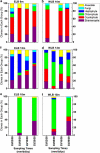Protist diversity in a permanently ice-covered Antarctic lake during the polar night transition
- PMID: 21390078
- PMCID: PMC3160681
- DOI: 10.1038/ismej.2011.23
Protist diversity in a permanently ice-covered Antarctic lake during the polar night transition
Abstract
The McMurdo Dry Valleys of Antarctica harbor numerous permanently ice-covered lakes, which provide a year-round oasis for microbial life. Microbial eukaryotes in these lakes occupy a variety of trophic levels within the simple aquatic food web ranging from primary producers to tertiary predators. Here, we report the first molecular study to describe the vertical distribution of the eukaryotic community residing in the photic zone of the east lobe (ELB) and west lobe (WLB) of the chemically stratified Lake Bonney. The 18S ribosomal RNA (rRNA) libraries revealed vertically stratified populations dominated by photosynthetic protists, with a cryptophyte dominating shallow populations (ELB-6 m; WLB-10 m), a haptophyte occupying mid-depths (both lobes 13 m) and chlorophytes residing in the deepest layers (ELB-18 and 20 m; WLB-15 and 20 m) of the photic zone. A previously undetected stramenopile occurred throughout the water column of both lobes. Temporal variation in the eukaryotic populations was examined during the transition from Antarctic summer (24-h sunlight) to polar night (complete dark). Protist diversity was similar between the two lobes of Lake Bonney due to exchange between the photic zones of the two basins via a narrow bedrock sill. However, vertical and temporal variation in protist distribution occurred, indicating the influence of the unique water chemistry on the biology of the two dry valley watersheds.
Figures



References
-
- Caron DA, Worden AZ, Countway PD, Demir E, Heidelberg KB. Protists are microbes too: a perspective. ISME J. 2009;3:4–12. - PubMed
-
- Fawley KP, Fawley MW. Observations on the diversity and ecology of freshwater Nannochloropsis (Eustigmatophyceae), with descriptions of new taxa. Protist. 2007;158:325–336. - PubMed
-
- Fietz A, Bleib W, Hepperle D, Koppitz H, Krienitz L, Nicklisch A. First record of Nannochloropsis limnetica (Eustigmatophyceae) in the autotrophic picoplankton from Lake Baikal. J Phycol. 2005;35:780–790.
-
- Fritsen CH, Priscu JC. Seasonal change in the optical properties of the permanent ice cover on Lake Bonney, Antarctica: consequences for lake productivity and dynamics. Limnol Oceanogr. 1999;44:447–454.
-
- Glatz RE, Lepp PW, Ward BB, Francis CA. Planktonic microbial community composition across steep physical/chemical gradients in permanently ice-covered Lake Bonney, Antarctica. Geobiol. 2006;4:53–67.
Publication types
MeSH terms
Associated data
- Actions
- Actions
- Actions
- Actions
- Actions
- Actions
- Actions
- Actions
- Actions
- Actions
- Actions
- Actions
- Actions
- Actions
- Actions
- Actions
- Actions
- Actions
- Actions
- Actions
- Actions
- Actions
- Actions
- Actions
- Actions
- Actions
- Actions
- Actions
- Actions
- Actions
- Actions
- Actions
- Actions
- Actions
- Actions
- Actions
- Actions
- Actions
- Actions
- Actions
- Actions
- Actions
- Actions
LinkOut - more resources
Full Text Sources
Molecular Biology Databases

